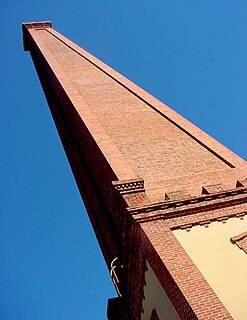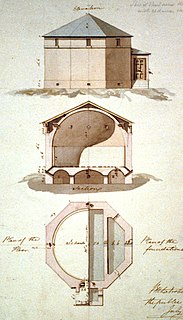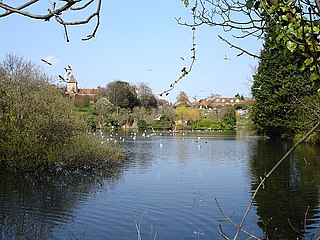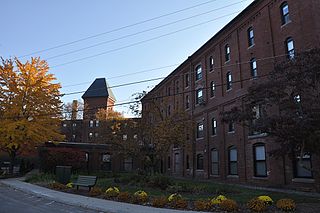Related Research Articles

Enfield is a town in Hartford County, Connecticut, United States, first settled by John and Robert Pease of Salem, Massachusetts Bay Colony. The population was 44,654 at the 2010 census. It is bordered by Longmeadow, Massachusetts and East Longmeadow, Massachusetts, to the north, Somers to the east, East Windsor and Ellington to the south, and the Connecticut River to the west.

Windham is a town in Cumberland County, Maine, United States. The population was 17,001 at the 2010 census It includes the villages of South Windham and North Windham. It is part of the Portland–South Portland–Biddeford, Maine Metropolitan Statistical Area.

Éleuthère Irénée du Pont de Nemours was a French-American chemist and industrialist who founded the gunpowder manufacturer E. I. du Pont de Nemours and Company. His descendants, the du Pont family, have been one of America's richest and most prominent families since the 19th century, with generations of influential businessmen, politicians and philanthropists. In 1807, du Pont was elected a member of the American Philosophical Society in his adopted hometown of Philadelphia.

The Little Miami River is a Class I tributary of the Ohio River that flows 111 miles (179 km) through five counties in southwestern Ohio in the United States. The Little Miami joins the Ohio River east of Cincinnati. It forms parts of the borders between Hamilton and Clermont counties and between Hamilton and Warren counties. The Little Miami River is one of 156 American rivers designated by the U.S. Congress or the Secretary of the Interior as a National Wild and Scenic River and lends its name to the adjacent Little Miami Scenic Trail.

The Confederate Powderworks was a gunpowder factory during the American Civil War, the only permanent structures completed by the Confederate States of America. Colonel George Washington Rains chose the old United States Arsenal site between the Canal and Savannah River in Augusta, Georgia, as a secure inland location with good rail and water connections.

The Merrow Sewing Machine Company, best known for inventing the overlock sewing machine, is a manufacturer of sewing machines. After the explosion of his gunpowder mill in 1837, in 1838 J.M. Merrow built a knitting mill on the same site. The company developed crocheting machines for its own use and by 1887 evolved to design, build and market sewing machines exclusively. During its early decades it was organized as a partnership under various names: established in 1838 as Joseph M. Merrow & Sons by J. Makens Merrow, then Pitkin, Merrow, & Co., renamed Merrow Manufacturing Co. in 1857, then Merrow and Millard in 1863, J.B. Merrow and Sons in 1870, and incorporated as The Merrow Manufacturing Company in 1893. Originally all of its manufacturing was done at facilities in Merrow, Connecticut, and then in Hartford, Connecticut, after 1894. The company is currently based in Fall River, Massachusetts.

The Peters Cartridge Company was a company in Kings Mills, Ohio that specialized in gunpowder and ammunition production. Its historic buildings, built in 1916 at 1415 Grandin Road, were added to the National Register of Historic Places on October 10, 1985.

Ballincollig Royal Gunpowder Mills was one of three Royal gunpowder mills that manufactured gunpowder for the British Government. Located in Ballincollig near Cork city in Ireland, the powder mills were originally opened in 1794 as a private enterprise, before being taken over by the British Government during the Napoleonic Wars.

A gunpowder magazine is a magazine (building) designed to store the explosive gunpowder in wooden barrels for safety. Gunpowder, until superseded, was a universal explosive used in the military and for civil engineering: both applications required storage magazines. Most magazines were purely functional and tended to be in remote and secure locations. They are the successor to the earlier powder towers and powder houses.

From 1802 to 1921, Eleutherian Mills was a gunpowder mill site used for the manufacture of explosives by the Du Pont family business, which was founded by Eleuthère Irénée du Pont. The name also refers to the house on the hill above the mills, which was the first Du Pont family home in America. In 1952, the site became an outdoor museum, and the Hagley Museum and Library was founded. The site was declared a National Historic Landmark in 1966.

Faversham, in Kent, England, has claims to be the cradle of the UK's explosives industry: it was also to become one of its main centres. The first gunpowder plant in the UK was established in the 16th century, possibly at the instigation of the abbey at Faversham. With their estates and endowments, monasteries were keen to invest in promising technology.
The Frankford Powder-Mill is a historic gunpowder factory in the Frankford neighborhood of Philadelphia, Pennsylvania.

A powder mill was a mill where gunpowder is made from sulfur, saltpeter and charcoal. Crude grinding and mixing operations like the Frankford Powder-Mill of Philadelphia were a cottage industry until the industrial revolution brought improved product quality through the following procedures:

The Wamesit Canal-Whipple Mill Industrial Complex is a historic mill and canal at 576 Lawrence Street in Lowell, Massachusetts. This industrial area of Lowell, located on the Concord River, underwent a major expansion from a more modest millworks in the mid-19th century by Oliver Whipple, a manufacturer of gunpowder.

Goes Station is a small unincorporated community in northern Xenia Township, Greene County, Ohio, United States. It sits at the intersection of Snively Road and U.S. Route 68 between Xenia and Yellow Springs.

California Powder Works was the first American explosive powder manufacturing company west of the Rocky Mountains. When the outbreak of the Civil War cut off supplies of gunpowder to California's mining and road-building industries, a local manufacturer was needed. Originally located near Santa Cruz, California, the company was incorporated in 1861 and began manufacturing gunpowder in May 1864. For 50 years, it was a major employer in the county, employing between 150 and 275 men. The powder works was located on a flat adjacent to the San Lorenzo River, three miles upstream of Santa Cruz.
Oriental Powder Company was a gunpowder manufacturer with mills located on the Presumpscot River in Gorham and Windham, Maine. The company was one of the four largest suppliers to Union forces through the American Civil War.

Laflin & Rand Powder Company was a gunpowder and early smokeless powder manufacturer notable for producing the smokeless powder used by United States Army infantry rifles from 1896 to 1908, which included the period of development of the M1903 Springfield rifle and .30-06 Springfield cartridge.
Austin Cartridge Company was an Austin Powder Company subsidiary manufacturing cartridge ammunition for small arms. The company made shotgun shells and rimfire cartridges from 1895 until purchased by Western Cartridge Company in 1907.
American Powder Mills (1883-1929) was a Massachusetts gunpowder manufacturing complex on the Assabet River. It expanded to include forty buildings along both sides of the river in the towns of Acton, Concord, Maynard, and Sudbury. Press mills, kernelling mills, glazing mills, and storehouses were dispersed over four-hundred acres to minimize damage during explosions. A narrow gauge railway transferred raw materials and products between the buildings.